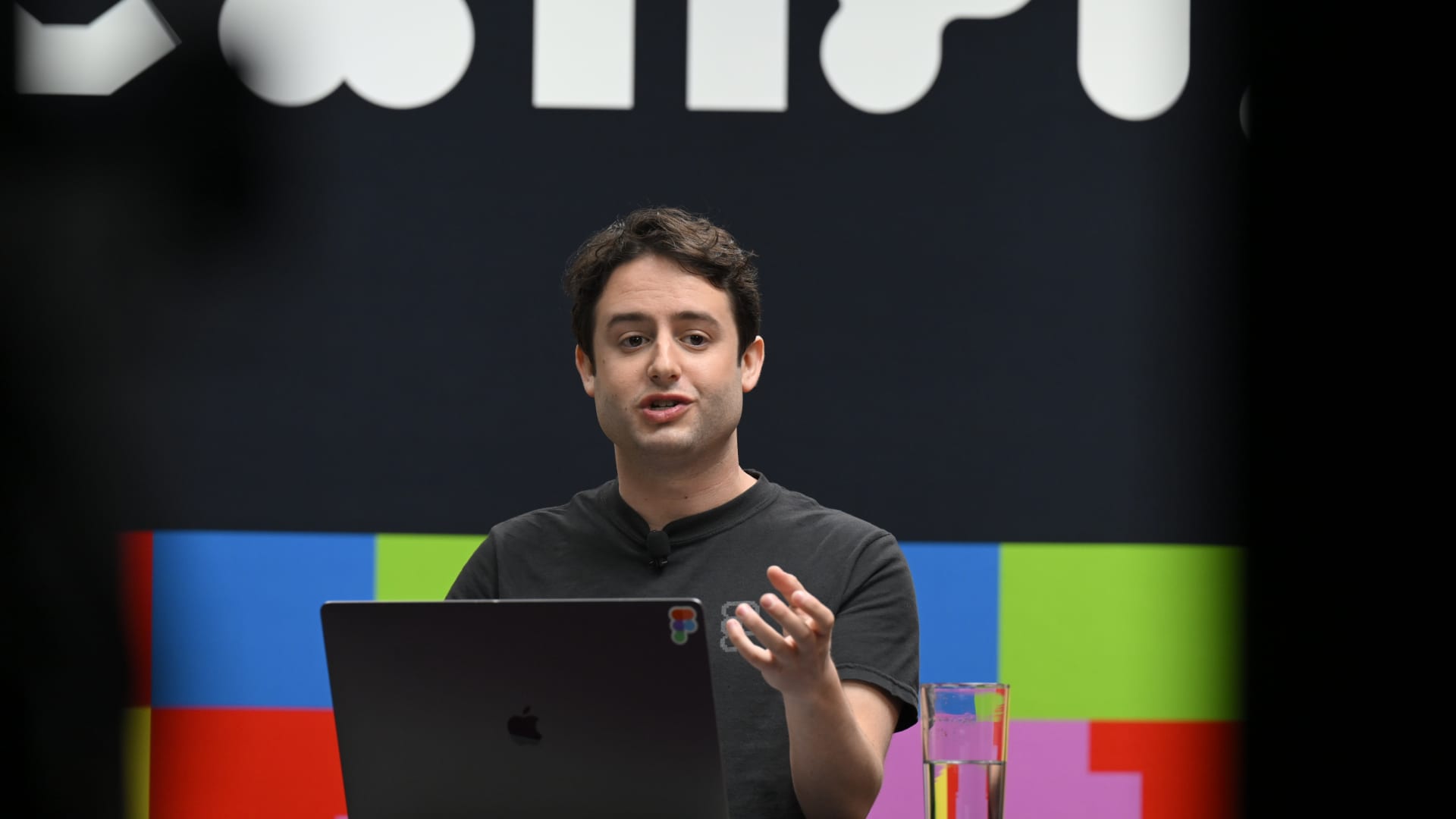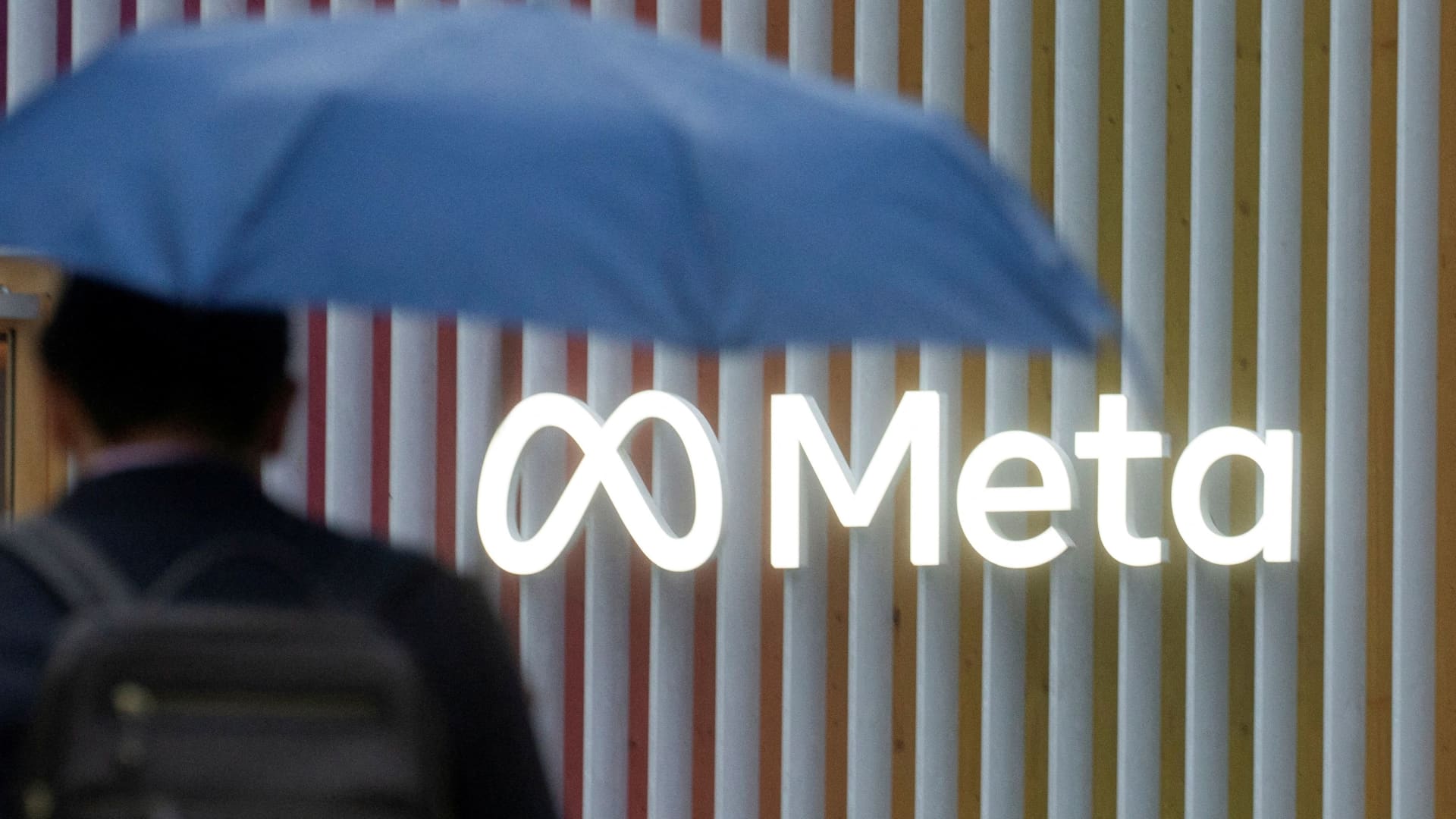Microsoft employees love Figma, and it’s testing the company’s cozy relationship with Adobe


Microsoft and Adobe have been friendly bedfellows for decades. Microsoft’s dominant PC operating system has been the gateway for Adobe to reach millions of business users with its design software.
The companies’ CEOs even attended the same high school in India, and both moved to the U.S. in the 1980s for graduate school in computer science. They share a common bond over the successful transition from desktop software to the cloud.
But inside Microsoft, an emerging challenge to Adobe is catching fire and raising questions about the future of one of the tech industry’s most intimate relationships.
Figma, a San Francisco-based startup that celebrated its 10th anniversary in August, is being used by tens of thousands of employees inside Microsoft and, for many, is at the heart of their daily work. The number of users has steadily increased in recent years, though neither company will say how many of them are editors with paid accounts.
The cloud-based design software came in the door in 2016, when Microsoft acquired mobile app development platform Xamarin and brought in a 350-person team that, months after the deal closed, would become Figma power users. The product has since become so central to how Microsoft’s designers do their jobs that Jon Friedman, corporate vice president of design and research, said Figma is “like air and water for us.” It’s also used by engineers, marketers and data scientists across Microsoft.
“Figma’s become, I would say, sort of the No. 1 common tool we use to collaborate across all of the design community in the community and beyond,” said Friedman, who’s worked at Microsoft for over 18 years. It’s “really great at helping us collaborate at scale, and at global scale. I can collaborate with teams we have in India, China, Europe, Israel and Africa.”
Venture investors have been all in on the growth.
In June 2021, during the heyday of mega financings, Figma was valued at $10 billion in a funding round that included participation from Morgan Stanley’s Counterpoint Global. That was before the 2022 market plunge sent many cloud stocks down by more than half and largely halted pre-IPO rounds.
Figma hasn’t announced plans for a stock market debut, and shareholders aren’t pressing for one anytime soon, in large part because the market for new offerings has dried up this year.
The company, backed by the likes of Index Ventures, Greylock Partners and Kleiner Perkins, now has the size and growth trajectory to land solidly on the radar of public investors. Annualized recurring revenue has more than doubled in consecutive years and is poised to top $400 million in 2022, according to people with knowledge of the company’s financials who asked not to be named because the numbers are confidential. Figma’s workforce has swelled to 800.
While Microsoft has served as a growth driver for Figma, spending millions a year on its deployment, the company’s software has also taken off at Google, Oracle and Salesforce, where it started small and grew organically as fans touted it to their colleagues. Other customers include Airbnb, Dropbox, Herman Miller, Stripe and Twitter.
After Figma founder and CEO Dylan Field tweeted earlier this month about the company turning 10 years old, he received flattering responses from Salesforce co-CEO Bret Taylor and Atlassian co-CEO Mike Cannon-Brookes. Taylor started his response with, “I [heart emoji] Figma.”
For Figma, getting traction inside big companies, particularly within Microsoft, has required going head-to-head with Adobe’s competing XD program, and winning its fair share of deals. That doesn’t mean the market has completely flipped, or that Adobe is being fully supplanted.
“We’re still heavy on Adobe Illustrator, Photoshop and XD,” Friedman said.
Adobe and Microsoft have worked together for more than two decades. In addition to Adobe gaining ubiquity by distributing across Windows machines, the two companies have been syncing their products in desktop, cloud and mobile computing, with over 50 integrations listed on Microsoft’s website.
Penetrating that alliance has not always been smooth for Figma. In 2016, Microsoft acquired Sunrise, a startup with a popular calendar app. The Sunrise team relied on Figma and continued to use it after the deal closed.
Sunrise co-founder Jeremy Le Van said his employees were among the lucky ones at Microsoft. He said some Microsoft staffers weren’t able to use Figma because of the business relationship with Adobe and were stuck using products such as Photoshop and XD. Despite executive resistance in certain departments, some designers snuck out of the Adobe ecosystem to use Figma anyway, said Le Van, who stayed on as a design director at Microsoft until 2018.
Friedman said he wasn’t aware of examples of Figma being shut out. “We have a great relationship with Adobe as well and love their products for many use cases at Microsoft,” he said.
The same year of the Sunrise deal, Adobe said it would make Microsoft’s Azure its preferred cloud for Creative Cloud, as well as the Marketing Cloud and Document Cloud. To mark the occasion, Microsoft CEO Satya Nadella and Adobe CEO Shantanu Narayen, who both went to high school at India’s Hyderabad Public School, appeared at Microsoft’s Ignite conference for IT professionals under a banner declaring that Adobe loves Azure.
‘We both wanted it’
Figma’s collaborative capabilities are central to its popularity. Multiple editors of a document can see one another working in real time, and non-editors can view designs and leave comments. Companies pay for Figma based on the number of editors they have for their files.
“Any designer, product manager or engineer can jump in and see the design system at play in any particular product,” Friedman said.
Last week, Figma released a version of its service that people can use in Microsoft’s Teams communication app, removing the need to open a browser tab.
“We both wanted it,” said Field, who started Figma after scoring a Thiel Fellowship, which came with a $100,000 grant from venture investor Peter Thiel on the condition that he drop out of college (Brown University) and pursue a new project.
The Teams integration is a tool that benefits any user of Microsoft products, not just employees. Adobe, which offers Teams apps for Acrobat and Creative Cloud, knows all about the power of tying into the Microsoft ecosystem. It’s been a big part of the company’s success in its 40-year run up to almost $17 billion in annual revenue.
Figma had to start small. Like many organizations, Microsoft began using it for free. Today, a customer can pay Figma each month based on the number of people who make changes to files, while a more limited version of the service is available at no cost.
In 2017, a year after the Xamarin acquisition, Field hosted Friedman at his company’s San Francisco headquarters. Field says he remembers asking Friedman why Microsoft didn’t want to keep using the free version of Figma.
“‘Look, we’re all worried you’re going to die as a company,” Field recalled Friedman telling him. “We can’t spread it inside Microsoft as a company even though we like it, because you’re not charging.”
It wasn’t just about keeping Figma alive. As a big-spending customer, Microsoft was in position to start asking for more features.
Field said Microsoft’s feedback led to several improvements. For example, Figma engineers worked to make it easier to move from screen to screen in a single Figma file. The company also added support for input from Xbox game controllers and made prototype previews work faster on mobile devices.
Ultimately, Microsoft’s requests helped Figma develop its top-tier enterprise plan, Field said, adding to the free version and paid monthly premium packages that range from $12 to $45 per editor per month. The enterprise package runs at $75 per editor and includes dedicated account managers and advanced password management.
Václav Vančura remembers when things were very different.
Vančura was a senior designer at Xamarin, whose software helped companies build Android and iOS apps with Microsoft’s C# programming language.
When Figma announced its launch in late 2015, Vančura was impressed with the company’s idea for shared design component libraries. He signed up for a preview release and received access in the summer of 2016. He encouraged his colleagues to jump on board, starting with David Siegel, Xamarin’s head of design.
Vančura and Siegel encountered snags while sharing files from design competitor Sketch. After one Xamarin employee uploaded a file to a Dropbox folder, their teammates sometimes struggled to get it running on their computers, either because they didn’t have the right fonts installed or because they had different versions of the software.
Unlike Sketch, which was only available on MacOS, Figma was on the browser. That meant fewer sharing issues. You grant others access by copying a link or entering their email addresses, just like in Google Docs. But performance was a problem.
Vančura made complex designs in Figma, causing the software to slow down, freeze and crash. The Xamarin workers sent Vančura’s files to Figma engineers, who made Figma speedier and more stable.
In 2017, Vančura flew from the Czech Republic, where he lives, to Seattle, and then made the short trek to Microsoft’s headquarters in Redmond. He took the opportunity to show Figma to his team, many of whom were accustomed to working in Photoshop and Illustrator.
“It was amazing. It was like watching Formula 1,” Vančura said. “There were so many mouse pointers on the screen, and everybody designed something, even if it meant they were pasting GIFs or drawing rectangles. All of them were so blown away. I think that was the moment these people figured out this was a huge time saver.”
Gaining traction
Siegel, who had become Microsoft’s head of design for developer services, wanted to get the word out more broadly that Microsoft was evolving and wasn’t stuck to its old isolated ways. In 2018, he posted a manifesto of sorts online.
“We use PCs, Macs, Figma, Sketch, GitHub, JavaScript, ZEIT, and other modern tools to design, prototype, and build the future of software development,” Siegel wrote on Xamarin’s website. There was a link to a Figma file that Microsoft employees could open.
The website reached the front page of Hacker News, a discussion board for software developers.
“This is some incredible self-awareness,” one commenter wrote.
Soon after, Benedikt Lehnert, a Microsoft product design director, told Friedman that the company needed everyone on the same program, whether it was Figma or XD. Microsoft chose Figma, Lehnert said.
Vančura said that at Microsoft, “Figma spread across the company so fast that I don’t think Adobe was even able to catch up.”
Figma isn’t shy about going up against an industry heavyweight. On its website, Figma says, “Don’t sync to the cloud with Adobe XD. Work in the cloud with Figma.” It asserts that designers are moving away from Adobe’s Creative Cloud bundle, the product that accounts for 59% of Adobe’s revenue.
in 2020, Adobe added Figma to the list of competitors it publishes in its annual report.
Analysts have raised questions about Figma to Adobe executives on at least three occasions this year. Alex Zukin of Wolfe Research asked during a January fireside chat with Adobe executives Scott Belsky and David Wadhwani if Figma was taking market share.
Belsky, Adobe’s product chief and executive vice president for Creative Cloud, didn’t answer the question directly. But he acknowledged that venture capitalists have been funneling money into the space.
“It is exciting that VCs see the same thing we’re seeing,” Belsky said. “Five-plus years ago, you didn’t see any material dollars going into the creative tools. I think now everyone sees that.”
Belsky said Adobe can take advantage of an opportunity to bring Creative Cloud to the web, which it’s done for Illustrator and Photoshop but not XD, a product that was launched in preview in 2016.
An Adobe spokesperson declined to talk about plans for a web version of XD, and said the company will talk about plans for Creative Cloud at its Max conference in October.
“We do not see an impact to the Photoshop business resulting from players in the product design category,” the spokesperson said. “We developed and have evolved Adobe XD to address the needs of our core design customers, who are designing marketing experiences for screens, rather than the distinct category of product design and development.”
Many challenges
Still, the pressure on Adobe is intensifying.
In the past three months, Figma’s app for iOS devices has consistently ranked above Adobe XD in the graphics and design section of Apple’s App Store, according to figures from Data.ai, formerly known as App Annie.
Wells Fargo analyst Michael Turrin said Figma has potential to expand.
“What Figma is trying to create is more of a broader platform that could become more of a system of record within this market, and that’s why I think this could become more important,” he said.
Figma isn’t the only upstart in the space making waves. An open-source alternative called Penpot, which can automatically generate the underlying source code for designs people make in the software, is also gaining momentum.
Microsoft employees are using Penpot and have contributed to it, said Pablo Ruiz-Muzquiz, who co-founded the project. Of the people who test Penpot, almost 20% are coming from Figma, he said.
Penpot’s code lives on GitHub, which Microsoft owns, under an open-source license, allowing people to download the code, modify it and run it on their own servers. That’s not true of Figma, which keeps its own source code private.
But Figma is evolving. One job description suggests Figma is considering a significant update to its iPad app that would provide a space to make new designs and not just view or share them.
And Figma has been busy expanding its executive ranks. In June, the company promoted Praveer Melwani, its head of business operations and finance, to the finance chief position. The next month, former Deutsche Bank and Goldman Sachs executive Kate DeLeo joined Figma as vice president of investor relations and business operations.
As the company marches toward an eventual introduction to Wall Street, getting more out of its relationship with Microsoft presents an opportunity for growth. Expanding the number of ways Figma gets used is one avenue.
“It works great as a presentation tool,” Friedman said.
Figma probably won’t ever replace Microsoft’s homegrown PowerPoint software or Adobe’s PDF format, but Field said his product boasts distinct advantages. For one, Figma avoids the problem of the non-stop back-and-forth emailing of a presentation by letting people simply share a link.
“I’d be surprised if there’s no salespeople at Microsoft that use it. My guess is there’s some,” Field said. “Is it significant? No, probably not.”
Not yet, anyway.
WATCH: Adobe CEO reacts to Q1 earnings: Our fundamentals continue to be extremely strong
This post has been syndicated from a third-party source. View the original article here.




